Linee guida per il reporting di sostenibilità - Global Reporting Initiative
Linee guida per il reporting di sostenibilità - Global Reporting Initiative
Linee guida per il reporting di sostenibilità - Global Reporting Initiative
You also want an ePaper? Increase the reach of your titles
YUMPU automatically turns print PDFs into web optimized ePapers that Google loves.
<strong>Linee</strong> <strong>guida</strong> <strong>per</strong> <strong>il</strong> <strong>reporting</strong> <strong>di</strong> sostenib<strong>il</strong>ità<br />
RG<br />
Panoramica sul <strong>reporting</strong> <strong>di</strong><br />
sostenib<strong>il</strong>ità<br />
Scopo del report <strong>di</strong> sostenib<strong>il</strong>ità<br />
Il <strong>reporting</strong> <strong>di</strong> sostenib<strong>il</strong>ità consiste nella misurazione,<br />
comunicazione e assunzione <strong>di</strong> responsab<strong>il</strong>ità (accountab<strong>il</strong>ity)<br />
nei confronti <strong>di</strong> stakeholder sia interni sia esterni, in relazione<br />
alla <strong>per</strong>formance dell’organizzazione rispetto all’obiettivo dello<br />
sv<strong>il</strong>uppo sostenib<strong>il</strong>e. L’espressione “<strong>reporting</strong> <strong>di</strong> sostenib<strong>il</strong>ità”<br />
assume un vasto significato ed è sinonimo <strong>di</strong> altre espressioni<br />
ut<strong>il</strong>izzate <strong>per</strong> <strong>il</strong>lustrare l’impatto economico, ambientale e<br />
sociale (ad esempio, triple bottom line, corporate responsib<strong>il</strong>ity<br />
<strong>reporting</strong>, ecc.).<br />
Il report <strong>di</strong> sostenib<strong>il</strong>ità dovrà fornire una rappresentazione<br />
equ<strong>il</strong>ibrata e ragionevole della <strong>per</strong>formance <strong>di</strong> sostenib<strong>il</strong>ità <strong>di</strong><br />
un’organizzazione, compresi gli impatti sia positivi sia negativi<br />
generati dal suo o<strong>per</strong>are.<br />
Il report <strong>di</strong> sostenib<strong>il</strong>ità che si basa sul GRI <strong>Reporting</strong> Framework<br />
<strong>il</strong>lustra i risultati e gli effetti che hanno caratterizzato <strong>il</strong> <strong>per</strong>iodo<br />
<strong>di</strong> ren<strong>di</strong>contazione relativamente a impegni, strategia e<br />
modalità <strong>di</strong> gestione dell’organizzazione. I report possono<br />
essere ut<strong>il</strong>izzati, tra l’altro, anche <strong>per</strong>:<br />
• svolgere analisi <strong>di</strong> benchmark e valutazione della<br />
<strong>per</strong>formance <strong>di</strong> sostenib<strong>il</strong>ità rispetto a quanto previsto da<br />
leggi, norme, co<strong>di</strong>ci, standard <strong>di</strong> <strong>per</strong>formance e iniziative<br />
su base volontaria;<br />
Guida al GRI <strong>Reporting</strong> Framework<br />
Tutti i documenti del GRI <strong>Reporting</strong> Framework sono <strong>il</strong> risultato<br />
<strong>di</strong> un processo volto ad ottenere <strong>il</strong> consenso, tramite <strong>il</strong> <strong>di</strong>alogo<br />
tra gli stakeholder, del mondo degli affari, degli investitori, dei<br />
sindacati, della società civ<strong>il</strong>e, dei professionisti <strong>di</strong> contab<strong>il</strong>ità<br />
e revisione, del mondo accademico, ecc..Tutti i documenti del<br />
<strong>Reporting</strong> Framework sono oggetto <strong>di</strong> verifica e soggetti a<br />
miglioramento continuo.<br />
Il GRI <strong>Reporting</strong> Framework vuole essere un modello<br />
universalmente accettato <strong>per</strong> <strong>il</strong> <strong>reporting</strong> della <strong>per</strong>formance<br />
economica, ambientale e sociale <strong>di</strong> un’organizzazione. Tutte<br />
le organizzazioni possono ut<strong>il</strong>izzarlo, in<strong>di</strong>pendentemente<br />
da <strong>di</strong>mensione, settore <strong>di</strong> attività o paese. Il modello include<br />
considerazioni pratiche comuni a <strong>di</strong>versi tipi <strong>di</strong> organizzazioni,<br />
dalle imprese più piccole a quelle <strong>di</strong> maggiori <strong>di</strong>mensioni,<br />
localizzate in <strong>di</strong>verse aree geografiche. Il GRI <strong>Reporting</strong><br />
Framework contiene argomenti sia <strong>di</strong> carattere generale sia<br />
settoriali, considerati da un’ampia gamma <strong>di</strong> stakeholder <strong>di</strong><br />
tutto <strong>il</strong> mondo applicab<strong>il</strong>i universalmente <strong>per</strong> comunicare la<br />
<strong>per</strong>formance <strong>di</strong> sostenib<strong>il</strong>ità <strong>di</strong> un’organizzazione.<br />
Le <strong>Linee</strong> <strong>guida</strong> <strong>per</strong> <strong>il</strong> <strong>reporting</strong> <strong>di</strong> sostenib<strong>il</strong>ità (in seguito<br />
anche le <strong>Linee</strong> <strong>guida</strong>) sono costituite dai Principi <strong>per</strong> in<strong>di</strong>viduare<br />
<strong>il</strong> contenuto del report e garantire la qualità delle informazioni<br />
fornite. Inoltre, includono l’Informativa standard composta da<br />
In<strong>di</strong>catori <strong>di</strong> <strong>per</strong>formance e <strong>di</strong> altra natura, così come in<strong>di</strong>cazioni<br />
su argomenti tecnici specifici sulla redazione del report.<br />
• <strong>di</strong>mostrare in che modo l’organizzazione influenza<br />
ed è influenzata dalle aspettative in tema <strong>di</strong> sv<strong>il</strong>uppo<br />
sostenib<strong>il</strong>e;<br />
• confrontare la <strong>per</strong>formance, sia nell’ambito <strong>di</strong> una stessa<br />
organizzazione sia tra <strong>di</strong>verse organizzazioni, nel corso<br />
del tempo.<br />
Figure 1: The GRI <strong>Reporting</strong> Framework<br />
Versione 3.0<br />
5

















